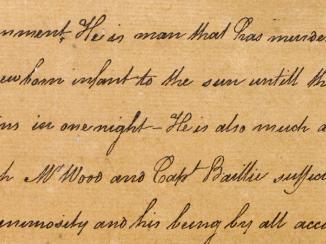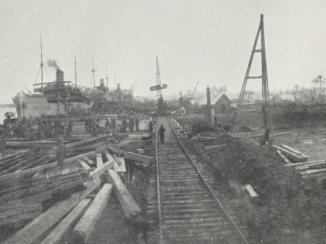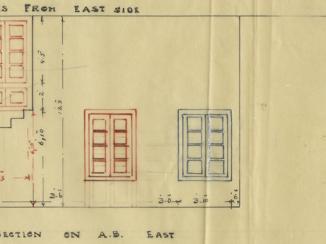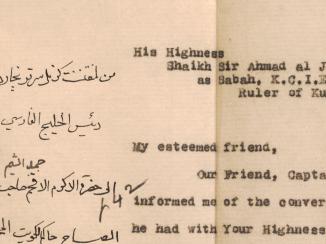Overview
The files of the Residency An office of the East India Company and, later, of the British Raj, established in the provinces and regions considered part of, or under the influence of, British India. Agency An office of the East India Company and, later, of the British Raj, headed by an agent. , Trucial Coast A name used by Britain from the nineteenth century to 1971 to refer to the present-day United Arab Emirates. , represent much of the surviving record of British administration in the region now known as the United Arab Emirates. Official relations between Britain and the ruling Shaikhs of this particular stretch of coastline began in 1806, with an agreement between the Resident at Muscat and the ruler of Ra’s al-Khaymah, Shaikh Sultan bin Ṣaqr al-Qasimi, and were further consolidated through the General Treaty with the Arab Tribes of the Persian Gulf An agreement made in 1820 between Britain and ten tribal rulers of the eastern Arabian coast, often seen as marking the start of 150 years of British hegemony in the region. of 1820, the Perpetual Maritime Truce of 1853, and the ‘Exclusive Agreement’ of 1892.


British representation began with the appointment of a Native Agent Non-British agents affiliated with the British Government. at Sharjah in 1825, whose duty was to maintain a channel of communication with the Shaikhs and gather information when possible. What became known as the Residency An office of the East India Company and, later, of the British Raj, established in the provinces and regions considered part of, or under the influence of, British India. Agent continued to administer from Sharjah with little change right up to the 1930s. Correspondence was carried out directly with the Political Residency An office of the East India Company and, later, of the British Raj, established in the provinces and regions considered part of, or under the influence of, British India. at Bushire [Bushehr], and some of these letters survive as part of the Residency An office of the East India Company and, later, of the British Raj, established in the provinces and regions considered part of, or under the influence of, British India. records.
Very few files have survived from the original collection of Agency An office of the East India Company and, later, of the British Raj, headed by an agent. records in Sharjah. It is probably no coincidence that the earliest surviving files date from the time when closer supervision was made possible with the transfer of responsibility to the Bahrain Agency An office of the East India Company and, later, of the British Raj, headed by an agent. , and the bulk of the files date from the period after the appointment of a British Political Officer in 1939; methodical record keeping before that time would have been extremely unlikely. This officer was based only seasonally at Sharjah and the Residency An office of the East India Company and, later, of the British Raj, established in the provinces and regions considered part of, or under the influence of, British India. Agent continued to perform his duties and correspond mostly in Arabic as before.
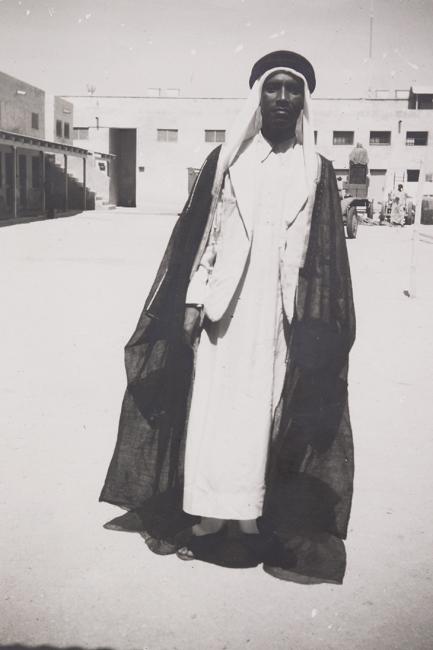
What types of records will you find?
The files are mostly made up of correspondence between the Residency An office of the East India Company and, later, of the British Raj, established in the provinces and regions considered part of, or under the influence of, British India. Agent, the British Political Officer, the Political Agency An office of the East India Company and, later, of the British Raj, headed by an agent. in Bahrain, and the Political Residency An office of the East India Company and, later, of the British Raj, established in the provinces and regions considered part of, or under the influence of, British India. in the Persian Gulf The historical term used to describe the body of water between the Arabian Peninsula and Iran. at Bushehr. The subject matter of the files reflects what was important to British colonial officials at that time: the establishment of an air route to British India through the Gulf and the ongoing search for previously untapped sources of oil in the Arabian Peninsula. Maps, formal agreements, and reports can all be found in the records. Most of the papers are in English, but a significant number are in Arabic and a few in Persian (Farsi).
How are the records organised?
The records are organised into files by subject. Each subject was allocated a number, followed where appropriate by an oblique stroke and a file number for every successive file opened on that subject. For example, files on the Sharjah Air Agreement (subject 0436) have the reference numbers 0436, 0436/2, and 0436/51. Gaps in the sequence of references, of which there are many, are likely to indicate material that has been either lost or destroyed, although a certain amount of haphazard record-keeping cannot be ruled out.
The files of the Residency An office of the East India Company and, later, of the British Raj, established in the provinces and regions considered part of, or under the influence of, British India. Agency An office of the East India Company and, later, of the British Raj, headed by an agent. in Sharjah are organised as follows:
IOR/R/15/4/1 ‘File 0205 Sharjah Affairs (Including Bani Qitab)’ (1937-1948)
IOR/R/15/4/2 ‘File 0210 Fujairah affairs’ (1941-1948)
IOR/R/15/4/3 ‘File 0255 Boundaries’ (1934-1949)
IOR/R/15/4/4 ‘File 0425 Copies of Agreements, Concessions etc’ (1930-1948)
IOR/R/15/4/5 ‘File 0436 Sharjah Air Agreement’ (1948-1950)
IOR/R/15/4/6 ‘File 0436/2 Sharjah Air Agreement’ (1950)
IOR/R/15/4/7 ‘File 0436/51 Sharjah Air Agreement’ (1951)
IOR/R/15/4/8 ‘File 0602 Imperial Bank of Iran - Banking Agreement & Bank Reports, Vol. 1’ (1945-1950)
IOR/R/15/4/9 ‘File 0629 Correspondence regarding the land beneath the sea outside territorial waters’ (1949-1950)
IOR/R/15/4/10 ‘File 0629/2 Correspondence regarding the land beneath the sea outside territorial waters’ (1950)
IOR/R/15/4/11 ‘File 3/1 Local affairs’ (1932- 1939)
IOR/R/15/4/12 ‘File 24/2 Oil concessions, Volume II’ (1937-1938)
IOR/R/15/4/13 ‘File 34/3 Imports and exports’ (1941-1942)
IOR/R/15/4/14 ‘File 34/3 Imports and Exports of goods’ (1937-1941)
IOR/R/15/4/15 ‘File 0190 Trucial Coast A name used by Britain from the nineteenth century to 1971 to refer to the present-day United Arab Emirates. News Diary’ (1946-1950)
IOR/R/15/4/16 ‘File 0216 Dispute over Khur Ghanadhah’ (1946-1948)
IOR/R/15/4/17 ‘File 0223 Ras Al Khaimah Affairs’ (1937-1949)

Related Records - The Bushire Residency and Bahrain Agency Files (IOR/R/15/1 and IOR/R/15/2)
Some of the early correspondence with the Agent at Sharjah can be found in what were known as ‘Translation Books’ or ‘Native Letters’. Examples of these Books and Letters include:
IOR/R/15/1/38 ‘Vol 44 Native letters Letters in Arabic and Persian written by Native Agents which often also contain, as enclosures, correspondence from notable figures in the Gulf and petitions raised by locals. outward’, 1826-1829
IOR/R/15/1/44 [Translation] ‘Book No: 52’, 1827-1828
IOR/R/15/1/48 ‘Vol 58 Native Letters Letters in Arabic and Persian written by Native Agents which often also contain, as enclosures, correspondence from notable figures in the Gulf and petitions raised by locals. Inward’, 1828-1829
IOR/R/15/1/50 ‘Vol 63: Draft Native Letters Letters in Arabic and Persian written by Native Agents which often also contain, as enclosures, correspondence from notable figures in the Gulf and petitions raised by locals. Outward’, 1829-1832
IOR/R/15/1/53 ‘Vol 67, 68: Native Letters Letters in Arabic and Persian written by Native Agents which often also contain, as enclosures, correspondence from notable figures in the Gulf and petitions raised by locals. Inward’, 1829-1830
IOR/R/15/1/59 ‘Vol 77: Native Letters Letters in Arabic and Persian written by Native Agents which often also contain, as enclosures, correspondence from notable figures in the Gulf and petitions raised by locals. Inward’, 1832
IOR/R/15/1/61 ‘Vol 80: Translation Book 1833 ( Native Letters Letters in Arabic and Persian written by Native Agents which often also contain, as enclosures, correspondence from notable figures in the Gulf and petitions raised by locals. Inward)’, 1833
IOR/R/15/1/66 ‘Vol 87: Translation Book, 1834 ( Native Letters Letters in Arabic and Persian written by Native Agents which often also contain, as enclosures, correspondence from notable figures in the Gulf and petitions raised by locals. Inward)’, 1834
IOR/R/15/1/68 ‘Vol 89 Translation Book, 1835 ( native letters Letters in Arabic and Persian written by Native Agents which often also contain, as enclosures, correspondence from notable figures in the Gulf and petitions raised by locals. inward)’, 1835
IOR/R/15/1/74 ‘Native Letters outward’, 1837
IOR/R/15/1/75 ‘Book No. 102’ [ native letters Letters in Arabic and Persian written by Native Agents which often also contain, as enclosures, correspondence from notable figures in the Gulf and petitions raised by locals. inward], 1837
IOR/R/15/1/78 ‘Vol 106: Translation Book, 1838 ( Native Letters Letters in Arabic and Persian written by Native Agents which often also contain, as enclosures, correspondence from notable figures in the Gulf and petitions raised by locals. Inward)’, 1838
IOR/R/15/1/79 ‘Vol 108: Native Letters Letters in Arabic and Persian written by Native Agents which often also contain, as enclosures, correspondence from notable figures in the Gulf and petitions raised by locals. Inward’, 1838-1839
IOR/R/15/1/85 ‘No 117 From August 1839 To May 1840. Translation Book Commencing 24th August’, 1839-1840
IOR/R/15/1/91 ‘Vol 125 Native Letters Letters in Arabic and Persian written by Native Agents which often also contain, as enclosures, correspondence from notable figures in the Gulf and petitions raised by locals. inward’, 1840-1841

From 1850 onwards correspondence was filed under specific subject headings. While separate volumes labelled ‘native letters’ were still maintained (IOR/R/15/1/180-182, ‘Native Letters Outward’, 1856-1872), copies and translations of correspondence with the Residency An office of the East India Company and, later, of the British Raj, established in the provinces and regions considered part of, or under the influence of, British India. Agent can also be found in those subject files relating to the Trucial Coast A name used by Britain from the nineteenth century to 1971 to refer to the present-day United Arab Emirates. , as for instance:
IOR/R/15/1/185 ‘17 File 592 I Runaway Sailors and Divers, Agreement with Trucial Chiefs for their Prevention’, 1878-1880
IOR/R/15/1/188 ‘32 File 654 Intrigues of Persian officials on Arab Coast’, 1887-1894
IOR/R/15/1/189 ‘33 File 665 Hostilities between Shaikh Zaid and Shaikh Jasim’, 1888-1890
IOR/R/15/1/190 ‘34 File 666 Threatened invasion of Oman by Ibn Rashid’, 1888-1889
IOR/R/15/1/191 ‘Agreements with the Trucial Chiefs and also with the Chiefs of Bahrain’, 1891-1900
IOR/R/15/1/196 ‘Sirri Island Occupation by the Persian Govt. 1887-1902’, 1887-1902
IOR/R/15/1/197 ‘B.11 668-II Sirri Island’, 1904-1910
IOR/R/15/1/246 ‘14/88 I Islands of Abu Musa, Tunb and Sir Abu Nu’air: questions of ownership’, 1871-1900
This method of filing took over entirely in the 1880s, such that all correspondence with the Residency An office of the East India Company and, later, of the British Raj, established in the provinces and regions considered part of, or under the influence of, British India. Agent can be found under the relevant subject. A useful example is IOR/R/15/1/239-294, ‘File 14: Arab Coast and Islands’, 1871-1948, but many other files also contain material on the Trucial Coast A name used by Britain from the nineteenth century to 1971 to refer to the present-day United Arab Emirates. . Most of these can be found by filtering searches based on the relevant place ( Trucial Coast A name used by Britain from the nineteenth century to 1971 to refer to the present-day United Arab Emirates. or specific Shaikhdom, such as Dubai) or person ( Native Agent Non-British agents affiliated with the British Government. or Political Agent A mid-ranking political representative (equivalent to a Consul) from the diplomatic corps of the Government of India or one of its subordinate provincial governments, in charge of a Political Agency. , Trucial Coast A name used by Britain from the nineteenth century to 1971 to refer to the present-day United Arab Emirates. ).
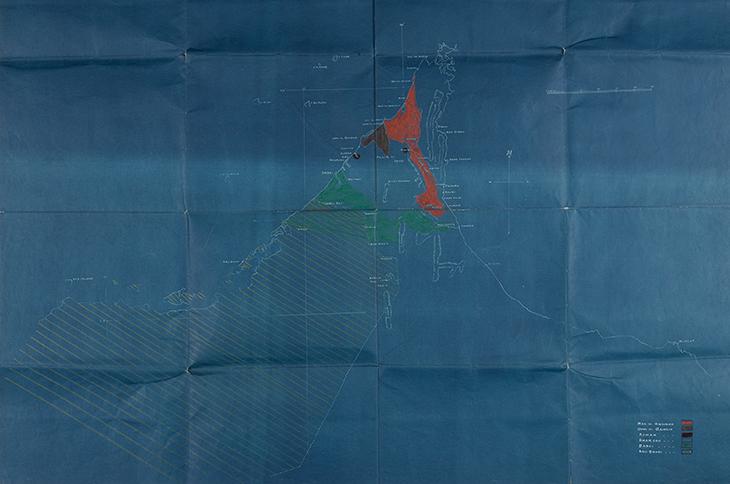
From 1932, due to the importance of negotiations over oil concessions and the development of air communications along the Arabian coast, responsibility for the Residency An office of the East India Company and, later, of the British Raj, established in the provinces and regions considered part of, or under the influence of, British India. Agency An office of the East India Company and, later, of the British Raj, headed by an agent. in Sharjah was transferred to the Political Agency An office of the East India Company and, later, of the British Raj, headed by an agent. in Bahrain. Thus, Trucial Coast A name used by Britain from the nineteenth century to 1971 to refer to the present-day United Arab Emirates. correspondence can also be found among the Bahrain Agency files from this point onward, again under the relevant subject (for example, IOR/R/15/2/616-625, ‘File 22: Trucial Coast’, 1933-1950 [currently only partially available on QDL]). Additional correspondence is located in the Bahrain Vernacular Office files (IOR/R/15/2/1824-1980, ‘Bahrain Agency An office of the East India Company and, later, of the British Raj, headed by an agent. , Vernacular Office Files’, 1926-1950) as Residency An office of the East India Company and, later, of the British Raj, established in the provinces and regions considered part of, or under the influence of, British India. Agents continued to correspond in Arabic. Despite the loss of documents there is a wealth of material relating to the Trucial Coast A name used by Britain from the nineteenth century to 1971 to refer to the present-day United Arab Emirates. and its affairs that can be located with a little knowledge of the administrative history.





